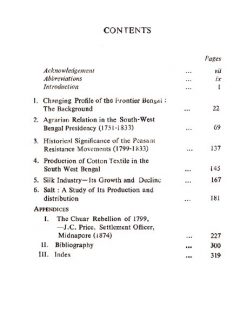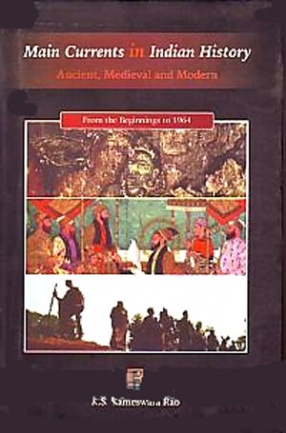The present volume is not only a chronological record of historical events that decided the political fate, but also the economic history of a turbulent region which the author rightly defines as the Frontier Bengal and which is more appropriately the South-West Bengal of the eighteenth century. Its territorial jurisdiction began to fluctuate with the addition and deletion of territories as a consequence of internecine feuds between the native chiefs and the alien rulers and also to suit for the latter’s administrative convenience. The period selected the author for this study starts from 1751, the year of the Treaty between Alilvardi Khan and Raghuji Bhonsle I of Nagpur, and extends up to 1833, the year of the passing of Charter Act and that of the dismemberment of the district of Jungle Mahals and of the ruthless suppressions of the sporadic agrarian revolts in the region. This is the period of transition which rang out the outdated feudal agrarian economy in the eastern India and heralded the dawn of a capitalist economy in the mid-nineteenth century, noted for the building up of factories and rail roads and associated phenomenon of the steam age in India. Within the eighty years the frontier line of the Bengal Presidency had been continuously extended like the ‘Wild West’ of America till the second half of the eighteenth century. In the course of his patient and persevering research, the author had to face acute paucity of authentic historical literature. He felt groping in the dark specially while searching statistical data regarding the general economic condition of the region which is an outstanding feature of this volume. The early British rule in the Jungle Mahals witnessed a momentous change in the life of the people who-content with their culture and political life were looked down upon as criminals by the officials of the East India Company. The turbulent jungle chiefs were dealt with in a hostile manner by demolishing their strongholds, disbanding their local militia and overpowering their military might. During the period covered by the author’s study, there were reolts of the jungle zamindars in 1965-73, the bloody Chuar Revolt of 1798-99, Khurda revolt of 1817. Ganga Narayan Hangama and the Kol Rebellion of 1833, Sonthal rebellion of 1856 (a year, before the famous Sepoy Mutiny) and the revolt of Surendra Sai of Sambalpur throughout the middle of the 19th Century. Besides describing the significance of the Peasant Resistance Movements (1799-1833), the author also describes creeping degeneration of cotton textile industry, the crisis in the agrarian economy, the growth and decline of silk industry, the fraudulent business practice of Company’s officials and above all the monopoly of salt trade and salt manufacture during this period. It is a unique book of its kind covering both the chronological as well as economic history of the period and should be a ‘must’ not only for libraries in the country and abroad but should also be the proud possession of all private book-shelves.
Crossings: Early Mediterranean Contacts with India
Out of stock







There are no reviews yet.